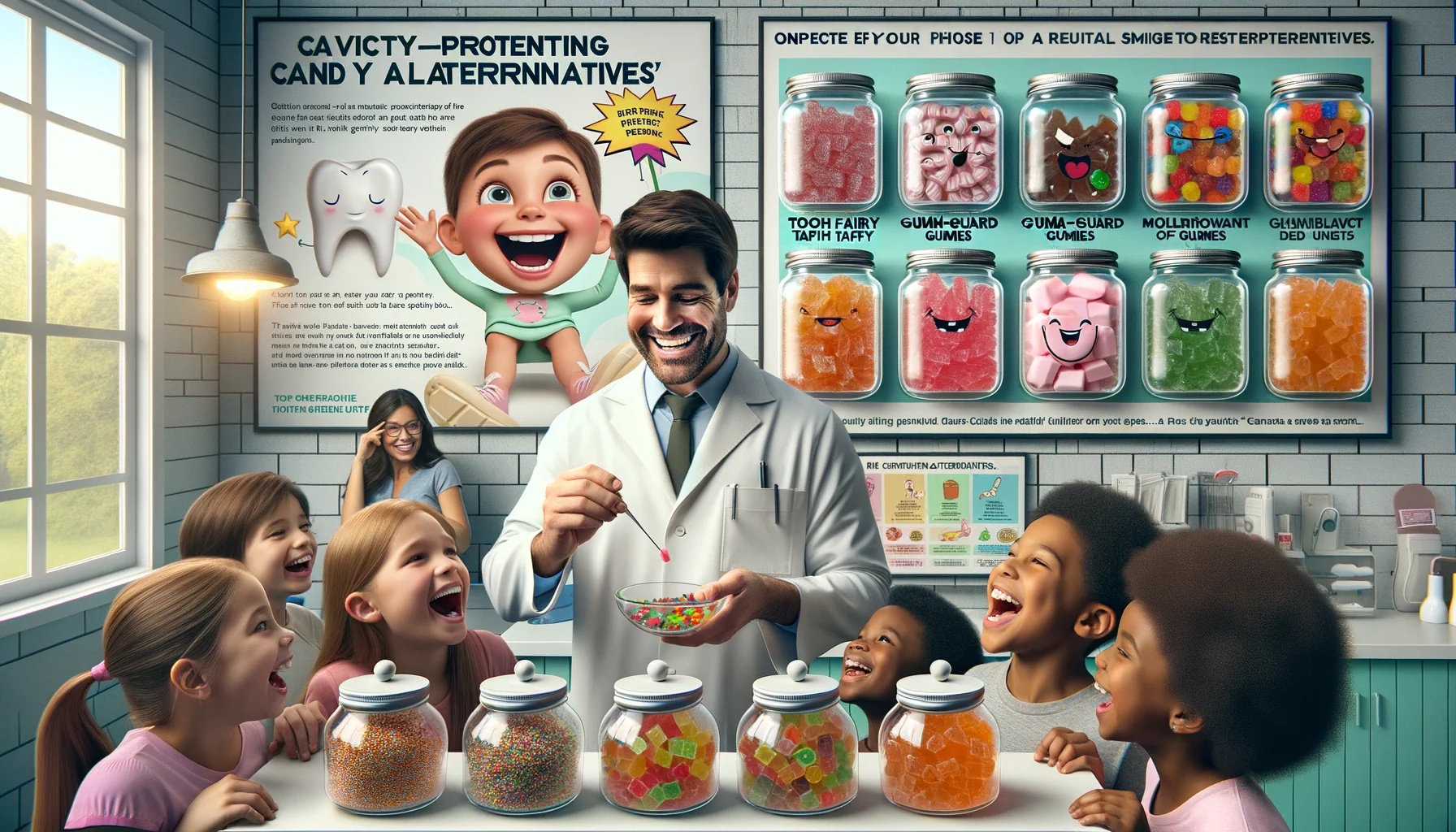Cavity-Preventing Candy Alternatives Quiz
Test Your Knowledge
Question of
Understanding Cavities and Sugar Impact
When I think about cavities, it's like recalling a childhood fear that seemed to lurk in every shadowy corner of a candy store. The science behind tooth decay, though, is less of a ghost story and more of an intriguing narrative about our bodies. You see, our teeth are constantly under siege by armies of bacteria, thriving on the sugars we ingest. It's a microscopic battle where sugar is the villain, providing fuel for bacteria to produce acids that erode the enamel, eventually leading to cavities.
It's not just about the sweet treats; it's the hidden sugars in foods we wouldn't suspect a sneaky granola bar here or a slice of bread there. These carbohydrates break down into simple sugars, inviting oral bacteria to feast. It's as if your mouth becomes a grand ballroom with bacteria dancing to the tune of decay. And while we can't shut down the party completely, understanding this process empowers us to be selective bouncers at the gates of our teeth.
The Science of Tooth Decay
How Sugar Contributes to Cavities
Tasting that first bite of a sugary snack is like diving into a pool of sweetness it's exhilarating. But little did I know that with every indulgence, I was unwittingly rolling out a red carpet for cavity-causing bacteria. Sugar acts as their primary source of energy, allowing them to multiply and produce acids that attack tooth enamel in what is known as demineralization. This process can be sneaky and silent, much like termites nibbling away at wood until one day you realize the integrity of your pearly whites has been compromised.
The Role of Oral Bacteria
Bacteria in our mouths are as natural as leaves on trees, but when they throw an acid-producing rave in response to sugar intake, that's when things go south. They cling to teeth and gums forming dental plaque a sticky film that can lead to gum disease if not addressed. Brushing and flossing disrupt this bacterial soiree, but they're persistent guests that don't take hints well. The key is limiting their favorite refreshments sugars and starches thus turning down the volume on their destructive party.
Nutritional Habits for Healthy Teeth
Foods That Promote Oral Health
Imagine your diet as a superhero team dedicated to protecting your teeth. Foods rich in calcium and phosphorus act like stalwart defenders rebuilding enamel, while crispy fruits and vegetables are the scrubbing heroes cleaning your teeth with every crunch. Fibrous foods stimulate saliva flow nature's mouthwash which neutralizes those pesky bacterial acids and washes away food particles. Its about creating an environment in your mouth where good health thrives over decay.
The Importance of a Balanced Diet
A balanced diet isn't just about fitting into those jeans from high school; it's also about fostering an oral ecosystem resilient against cavities. Every sip of water, every bite of nutrient-dense food is like equipping your teeth with armor against the onslaught of decay. A diet low in sugary snacks and high in vitamins helps maintain an army of saliva ready to defend against bacterial invaders at any given moment.
Identifying High-Risk Sugary Snacks
Common Cavity-Causing Candies
Stepping into a candy store used to feel like entering a wonderland until I realized that each gummy bear was more akin to a tiny saboteur for my dental health. Chewy candies stick around longer than an awkward guest, clinging to teeth and creating ideal conditions for cavity formation. Hard candies dissolve slowly, bathing your teeth in sugar longer than you'd bathe in a tub after a stressful day.
Reading Labels for Hidden Sugars
I once thought reading labels was strictly for calorie-counters or fitness enthusiasts. However, it turns out these labels are treasure maps revealing hidden sugars lurking within seemingly innocent foods. Words ending in "-ose," such as fructose or sucrose, are secret handshakes among sugars telling you they're present even when you least expect them. Becoming literate in label language helps keep your dental health on track by avoiding those secret sugar parties thrown by high-risk snacks.
- Gummy candies: Beware their chewy allure!
- Lollipops: A vortex of sugar swirling around your teeth.
- Soda: Not just bad for your waistline but also an enamel eraser!
- Sport drinks: Masquerading as healthful yet often packed with sugars.
- Fruit snacks: Fruit in name only; many are mere cousins twice removed from actual fruit content.
Natural Sweeteners That Protect Teeth
As I sit here reminiscing about the times when my sweet tooth had its way with me, I can't help but chuckle at the irony. Those little indulgences, those moments of "just one more piece," they often led to a stern look from my dentist. But who could blame me? The allure of sweetness is almost magnetic. However, my journey towards a healthier smile has introduced me to a treasure trove of natural sweeteners that not only satisfy my cravings but also come bearing gifts for my oral health.
These natural sweeteners are like the undercover agents in the world of confections. They're the unsung heroes that sweeten your life without leaving a trace of guilt or cavities. Let's dive into this pool of sweetness that's kind to your teeth and discover some tooth-friendly alternatives that could very well change the game for both your palate and your dental check-ups.
Benefits of Xylitol for Oral Health
I remember the first time I heard about xylitol. It sounded more like something you'd find in a science lab than in your pantry. But oh, how this sugar alcohol has changed my view on indulgence! Xylitol is not just a mere substitute; it's a champion for oral health, armed with benefits that could make your dentist's heart flutter with joy.
Xylitol's Anti-Cavity Properties
Imagine a sweetener that actually fights against the formation of cavities sounds too good to be true, right? Well, xylitol is famed for its ability to reduce the amount of cavity-causing bacteria in the mouth. It does this little dance where it tricks bacteria into thinking it's their favorite meal, only to leave them starving since they can't metabolize it. This reduction in bacteria means fewer acid attacks on your enamel and a happier, healthier smile.
Incorporating Xylitol in Your Diet
Incorporating xylitol into your diet can be as fun as embarking on a culinary adventure. You'll find it in various forms from gums and mints that freshen your breath while protecting your teeth, to granulated xylitol that you can sprinkle over your morning oatmeal or use in baking those guilt-free cookies. Just imagine: enjoying sweets without the fear of cavities lurking around every bite!
Stevia as a Tooth-Friendly Alternative
Then theres stevia nature's answer to our pleas for a no-calorie sweetener that doesn't compromise on taste or dental health. Derived from the leaves of the stevia plant, this sweetener brings joy to both dieters and dentists alike.
How Stevia Differs from Sugar
The magic of stevia lies in its unique composition. Unlike sugar which teases our taste buds before wreaking havoc on our teeth, stevia provides that desired sweetness without feeding harmful oral bacteria or spiking blood sugar levels. This means you can savor that delightful sweetness without inviting cavities to the party.
Creative Ways to Use Stevia
- Add a few drops into your morning coffee or tea for an instant lift-me-up without any dental guilt.
- Mix it into yogurt or homemade salad dressings for an unexpected twist of sweetness.
- Use stevia-based syrups as toppings for pancakes or waffles during a lazy Sunday brunch.
Erythritol and Dental Benefits
Last but certainly not least is erythritol. Some might say it's the dark horse among its peers, but once you get acquainted with its dental benefits, you'll want this underdog by your side at every dessert duel.
Understanding Erythritol's Safety Profile
Erythritol comes with an impressive safety profile; it's been studied extensively and found to be safe for consumption by all age groups. What sets erythritol apart is its smaller molecular size this means it doesn't cause digestive distress like some other sugar alcohols might. And when it comes to oral health? Erythritol plays no games actively working to prevent cavities and plaque build-up without compromising on taste.
Erythritol-Infused Products
The market is abuzz with erythritol-infused products designed to make life sweeter for those looking out for their pearly whites. From hard candies that dissolve slowly releasing their cavity-fighting powers, to chocolate bars that let you indulge without worry erythril-infused products are changing the face of guilt-free snacking one delicious bite at a time.
Delicious Cavity-Preventing Snacks
Oh, the bittersweet symphony of life with a sweet tooth! We've all been there, standing in the candy aisle, our inner child gazing longingly at the kaleidoscope of sugary wonders, while the adult in us sternly reads the label, whispering about cavities and dental bills. But what if I told you that indulgence doesn't have to be a forbidden fruit? Let's dive into a world where delicious meets dentally conscientiousa smorgasbord of cavity-preventing snacks that satisfy cravings while keeping those pearly whites intact.
The secret lies in nature's bounty and some clever culinary creativity. These tooth-friendly treats aren't just about dodging sugar's sneaky left hook; they're about embracing flavors that make our taste buds do a happy dance. And let's be honest, there's something empowering about chomping on snacks that won't send you sprinting to the dentist. It's like finding out your favorite superhero is also your dentistfighting cavities one tasty bite at a time.
So, imagine this: You're reaching for a snack, and instead of guilt, there's this warm glow of satisfaction because you know you're about to embark on a flavorful adventure without the plaque plot twist. That's what we're aiming forsnacks that are not only scrumptious but also champions of oral health. Lets unwrap these goodies together!
Fruit-Based Treats for a Sweet Tooth
When life gives you lemons... make lemonade-flavored fruit leather? Fruit-based treats are Mother Nature's candyand she's quite the confectioner. These natural sweets come packed with vitamins and fibers that whisper sweet nothings to our enamel rather than corroding it with processed sugars.
Making the Switch to Fruit Snacks
The transition from processed sugar to fruit-based snacks is like swapping out those high heels for your favorite sneakerscomfort without sacrificing style (or flavor). And don't worry; fruit snacks can be as varied and exciting as any candy aisle contender. Think dried mangoes doing the tango with your taste buds or apples slices dipped in almond butter playing peekaboo with your palate.
Recipes for Homemade Fruit Candies
Roll up your sleeves because it's time to play Willy Wonka in your very own kitchen laboratory. Concocting homemade fruit candies is both an art and a sciencea delicious experiment where you get to lick the spoon (and everything else). From berry-infused gummies to banana chips sprinkled with cinnamon stardust, these recipes are not just treats; they're edible victories over cavity-causing villains.
- Fruity Gummy Squares: Blend up your favorite berries, add a touch of honey and some agar-agar for that gummy bounce, pour into molds, and voilanatures answer to gummy bears!
- Citrus Peel Twists: Save those orange peels! Candy them in a light syrup, dust with a pinch of sugar substitute if needed, and let them dry into chewy, zestful delights.
- Baked Apple Chips: Thinly slice apples, sprinkle with cinnamon or nutmeg, and bake until crispan autumnal treat year-round!
Dairy Delights That Strengthen Enamel
Sometimes I think cows are onto something. Theyve got this whole milk business figured outchock-full of calcium for building strong bonesand teeth! Dairy delights arent just a creamy dream; theyre enamels knight in shining armor.
Cheese Varieties That Fight Decay
You know how superheroes have different powers? Well, cheese varieties are kind of like that when it comes to fighting decay. Cheddar acts like its wearing an invisibility cloak against cavities; mozzarella throws sticky-sweet traps off balance; Gouda neutralizes those acid-producing bacteria goonsits an epic battle royale in your mouth!
Yogurt-Based Snack Ideas
Moving on from cheeses valiant efforts, lets talk yogurtthe smooth operator of oral health. Its probiotics are like little warriors restoring peace in the realm of our mouths. Plus, yogurt is versatile; throw in some nuts or maybe some berries (look at us being all full-circle), and you've got yourself a snack thats as delectable as it is dependable against dental drama.
A dollop of Greek yogurt mixed with honey and topped with granola isnt just breakfastits an anytime indulgence that whispers sweet affirmations like "You're making great choices" while simultaneously winking at your sweet tooth.
Nut and Seed Snack Options
I often marvel at how something so small can pack such a punchjust like nuts and seeds when it comes to snacking righteously. These tiny titans are brimming with nutrients that form an alliance with our oral health by providing essential minerals without inviting sugar bugs to the party.
Almonds, Walnuts, and Oral Health
You know how almonds are often showing off their versatility? Well here they are again flaunting their high calcium content which aids in strengthening teeth. Walnuts? They dont like to brag but theyre full of omega-3 fatty acids which contribute to keeping inflammation away from our gums. Eating these nuts is essentially sending reinforcements for your teeths defense system.
Eating nuts straight from the shell can feel oddly satisfying toolike cracking codes or solving mysteries... except you get to eat the evidence!
Seeds as Nutritious Candy Replacements
If nuts were part of an ensemble cast, seeds would be their scene-stealing co-stars. We're talking sunflower seeds batting away bacteria with their high phosphorus content or pumpkin seeds serenading enamel with their zinc-rich melodies.
Incorporating seeds into your snacking repertoire brings excitementa crunchy chorus line supporting your smiles spotlight moment without fear of cavities creeping up on stage uninvited.
Innovative Cavity-Fighting Confections
There's a certain magic in the world of sweets, a sugary landscape where indulgence meets imagination. But as much as my heart flutters at the sight of a candy jar, I can't ignore the silent alarm bells that ring for my dental health. Imagine my delight when I discovered that confectioners have been conjuring up cavity-preventing alternatives to traditional treats. These innovative candies come with promises of sweet bliss minus the toothache, and I couldn't wait to delve into these guilt-free pleasures.
The journey felt like a treasure hunt, each discovery more intriguing than the last. From gums that freshen breath and fortify enamel to chocolates that hug your teeth with kindness, these are not just confectionsthey're confidants in your quest for oral health. As I savored each piece, I realized that this was more than just about avoiding cavities; it was about embracing a lifestyle where you can have your candy and eat it too.
Chewing Gums with Dental Benefits
In my quest for tooth-friendly sweets, I stumbled upon the world of chewing gums that promised to be allies in dental care. It turns out, not all gum is created equal; some are imbued with ingredients that could make your dentist proud. There's something incredibly satisfying about unwrapping a stick of gum, knowing it's packed with benefits beyond fresh breath.
The act of chewing itself is like sending an RSVP to saliva production, which is nature's way of giving our mouths a good rinse. And as someone who often forgets to drink water, I found this to be a delightful two-in-one: hydrating while keeping my teeth in check. The experience is akin to turning a mundane habit into a mini-celebration of oral health.
Selecting the Best Sugar-Free Gum
When selecting sugar-free gum, it's like being a detective on a case called "The Mystery of the Missing Cavities." You look for clues on the packagingwords like xylitol or sorbitolwhich hint at sweeteners that bacteria can't feast upon. Choosing the right gum becomes less about curbing sweet cravings and more about picking your teeth's next line of defense.
It's important to remember that not all sugar-free gums are created equal. Some wear their 'sugar-free' badge proudly but hide other culprits that can still lead to dental distress. So, read those labels like you're deciphering an ancient script; your teeth will thank you for it.
How Chewing Gum Can Prevent Cavities
- Stimulates Saliva: Increased saliva flow helps neutralize acids produced by bacteria.
- Removes Food Particles: Chewing gum acts like a gentle broom, sweeping away bits of food that might otherwise linger and invite cavities.
- Delivers Protective Ingredients: Many gums are infused with ingredients like calcium and phosphate, which can help remineralize tooth enamel.
- Discourages Snacking: Popping in a piece of gum can deter you from reaching for sugary snacks between meals.
Chocolate Alternatives That Are Teeth-Friendly
Now let's talk chocolateyes, chocolate! It might come as a surprise that this velvety indulgence can be fashioned into an ally against cavities. As someone who has whispered sweet nothings to chocolate bars before devouring them wholeheartedly, discovering teeth-friendly versions felt like uncovering a secret society within the world of cocoa.
These aren't your typical supermarket checkout chocolates; they're sophisticated cousins with degrees in dental hygiene. They swap out sugars with kinder alternatives and embrace cocoa's natural bitterness as part of their charma grown-up take on sweetness.
The Advantages of Dark Chocolate
The advantages of dark chocolate read like love letters penned by nutritionists: rich in antioxidants, low in sugar, and oh so sumptuous on the tongue. This is chocolate that doesn't just melt in your mouthit also whispers reassurances about your enamel's well-being.
Dark chocolate is akin to finding an unexpected friend within temptation itself. It offers up its polyphenols and flavonoidscompounds known for their protective propertiesand asks for nothing but your enjoyment in return. It feels rebellious in its own right; indulgence without consequence.
Cocoa Products with Reduced Sugar Content
Cocoa products have been shedding their sugary coats and stepping out in sleeker attirereduced sugar content that doesn't compromise on flavor. This isn't just about cutting calories; it's about crafting experiences where every nibble doesn't feel like a gamble with your gums.
These cocoa products charm you with their depth and complexity rather than overwhelming sweetnessa refined approach to dessert that leaves both taste buds and teeth contented. It's proof that sometimes less really is more.
Hard Candies Made with Safe Sweeteners
Hard candies have long been the sparkling jewels of confectionerya kaleidoscope of colors promising bursts of flavor upon every suckle. Yet behind their shiny veneer lurked the specter of cavities waiting to pounce at first bite\.or so I thought until I encountered hard candies made with safe sweeteners.
These aren't just treats; they're tiny guardians clad in crystalline armor ready to defend against tooth decay while delighting your senses. They've traded in their harmful sugars for sweeteners like xylitola substance notorious among bacteria for being undigestible yet deliciously deceitful on our tongues.
Choosing Tooth-Safe Hard Candies
Choosing tooth-safe hard candies is similar to picking out pearls from pebbles along the shorelineyou search for those glistening gems that promise purity and safety for your pearly whites. When you find them, it feels like winning a small victory against cavity-causing villains lurking in every corner candy aisle.
The key lies in ingredients such as xylitol or erythritolnatural sweeteners that don't just dodge cavities but may actually arm your teeth against them. Its candy consumption turned strategic maneuvera delightful plot twist in the narrative of dental care.
The Appeal of Flavored Xylitol Lozenges
Then there are the flavored xylitol lozengeseach one an ode to ingenious simplicity wrapped up in cellophane twists. These lozenges arent just treats; theyre little lifeboats offering respite from the stormy seas of oral bacteria overgrowth.
With flavors ranging from minty fresh to tropical tangs, these lozenges turn oral health into an adventure across taste territories uncharted by traditional candies. They dissolve slowly over timea leisurely journey across your palategranting ample time for xylitols cavity-preventing powers to take effect.
Creating a Cavity-Preventive Eating Plan
Designing a Balanced, Low-Sugar Menu
When I think about the sweet symphony of flavors that once danced across my palate, I often reminisce on the sugary delights that were, admittedly, not so friendly to my pearly whites. In a quest to prevent cavities without sacrificing joy, I discovered the art of creating a balanced, low-sugar menu. It's like being a maestro in your own kitchen, orchestrating a harmony of tastes that sing to your taste buds while keeping those dental nightmares at bay.
Crafting daily meal plans with an emphasis on oral health is not just about avoiding sugarit's about finding delectable alternatives that pamper your mouth with nutrients without inviting cavities to the party. Imagine sinking your teeth into a crisp apple slice instead of a gooey caramel chew; it's nature's candy offering both sweetness and a satisfying crunch. As I explored this new culinary landscape, I found that integrating whole grains, lean proteins, and an abundance of fruits and vegetables wasn't just good for my teethit was an adventure for my senses.
Daily Meal Planning for Oral Health
Every morning begins with intention, as I carefully select foods that will support my oral ecosystem throughout the day. Breakfast might feature a bowl of steel-cut oats sprinkled with cinnamon and topped with fresh berriesan antioxidant-rich feast that keeps sugar fiends at arm's length. For lunch and dinner, plates are vibrant with leafy greens and colorful veggies, alongside quinoa or grilled chicken. These meals are not only visually appealing but also packed with vitamins and minerals essential for strong enamel and overall dental health.
Snack Ideas That Won't Harm Teeth
Snacking need not be the villain in our cavity-prevention tale. In fact, it can be an interlude of delight when done right. My snack drawer now boasts an array of tooth-friendly options:
- Almonds and cheese pairing protein with calcium for a satisfying crunch.
- Hummus with bell pepper strips a zesty combo that's kind to my grin.
- Yogurt with a drizzle of honey just enough sweetness to whisper sweet nothings to my sweet tooth.
Each snack serves as an act of self-carea small rebellion against the cavity-causing culprits of yore.
Hydration and Its Role in Preventing Cavities
Who knew that something as simple as water could be such an unsung hero in our dental odyssey? Staying hydrated is like having your own personal mouthguard against cavities. Each sip rinses away food particles and dilutes acids produced by bacteriaessentially giving plaque the cold shoulder.
And let me tell you, carrying around my trusty water bottle has become a ritual as sacred as the morning coffee run used to be. Water isn't just life-sustaining; it's teeth-preserving. It's become my liquid ally in the fight against tooth decay, standing by me through thick and thinand meals and snacks!
The Importance of Drinking Water
There's nothing quite like the pure, revitalizing taste of waterthe ultimate palate cleanser. It plays an understated yet pivotal role in maintaining oral hygiene. By encouraging saliva production, water acts as nature's mouthwash, washing away potential cavity-causing leftovers from our indulgences.
Herbal Teas as Healthy Beverage Choices
On those days when water seems too plain for my whimsical taste buds, I turn to herbal teasa carnival of flavors without the sugar rush. Chamomile whispers relaxation through its gentle essence while peppermint leaves a kiss of coolness, both leaving no room for enamel erosion or cavities to settle in.
Timing of Meals and Snacks for Dental Protection
The clock ticks away not only time but also influences the state of our dental healthsomething I learned after one too many midnight snack rendezvous resulting in less-than-stellar visits to the dentist. Timing truly is everything; spacing out meals and snacks ensures that our saliva can do its job properly between feasts.
It turns out that those little breaks between eating aren't just pauses; they're periods of healing for our teeth. By aligning meal times with our body's natural rhythms, we give our mouths the chance to recuperateeach gap between bites is an opportunity for remineralization and defense against cavities.
Best Practices for Eating Frequency
Adopting best practices when it comes to eating frequency has been akin to fine-tuning an instrumentthe results are simply more harmonious. I aim for regular intervals between meals to keep acid attacks at bay and give my saliva ample time to neutralize pH levels in my mouthlike setting up invisible shields protecting each tooth.
Understanding the Impact of Eating Timing on Teeth
Grasping the impact of eating timing on teeth was like uncovering a secret spell for oral health magic. By limiting snacking and being mindful about not constantly exposing my teeth to food (and potential plaque-forming sugars), I've found greater balancenot only in my diet but also in maintaining a cavity-free smile full of confidence.
Educating Children on Sweet Alternatives
Fun and Engaging Ways to Teach Kids About Oral Care
Imagine a world where the sticky, sugary treats that children love don't come with a side of cavities and dental woes. It's not just a fairy tale; it's the result of educating our little ones on sweet alternatives that are kind to their teeth. How do we embark on this magical journey? By making oral care education as captivating as the latest animated blockbuster. Think about transforming the act of brushing teeth into a heroic quest where each brush stroke banishes plaque monsters. Or picture an app that transforms flossing into a high score-chasing game.
But let's not stop at just brushing and flossing. I've discovered that integrating interactive games for dental health can be incredibly effective. Imagine a board game where each space represents a different food choicelanding on an apple advances you forward, but a sticky caramel might send you back to rinse with mouthwash. The laughter and learning go hand-in-hand, like peanut butter and jellybut the sugar-free kind!
And then there are storybooksoh, the power of a good tale! Storybooks that encourage healthy eating habits can take children on adventures where heroes crunch on carrots instead of candy bars, and where mystical creatures sip water instead of soda. It's storytelling with a purpose, and the moral of these stories is always bright smiles and fewer trips to the dentist.
Kid-Friendly Cavity-Preventing Treats
As I delve into the world of kid-friendly cavity-preventing treats, I can't help but feel like a culinary wizard concocting potions for good oral health. Preparing appealing snacks for youngsters doesn't have to be bland or boringin fact, it should be quite the opposite! Picture vibrant fruit kebabs that look like edible rainbows or yogurt parfaits layered like sedimentary rocks holding fossils of fresh berries.
- Frozen Banana Pops dipped in dark chocolate and sprinkled with nutsan orchestra of textures singing in harmony.
- Crunchy homemade granola bars sweetened with a drizzle of honeyeach bite is a whisper of sweetness rather than a shout.
- Smoothies that hide leafy greens beneath a masquerade of mangoes and strawberriesa sneaky yet brilliant way to include vitamins.
Let's not forget about involving our little chefs in the kitchen! Healthy treat recipes kids can make not only empower them but also teach them valuable lessons about what goes into their bodies. Picture small hands shaping oatmeal cookie dough made with applesauce instead of sugar or decorating their own mini whole-grain pizzas topped with an array of colorful veggies. It's messy, it's fun, and it's deliciously educational.
Setting a Positive Example with Smart Food Choices
The apple doesn't fall far from the tree, they say, which is why setting a positive example with smart food choices is crucial in guiding our children towards healthy habits. Role modeling with your own snack selection becomes an unspoken lesson in making choices that benefit our bodies. When kids see us reaching for carrot sticks over potato chips or sipping on herbal tea instead of sugary soft drinks, those images stick like gum on hot pavementonly much easier to remove!
Involving kids in grocery shopping and label reading turns an ordinary chore into an undercover mission to find tooth-friendly foods. It's like being detectives in an aisle full of culprits where sugar often disguises itself under aliases like corn syrup or dextrose. Deciphering nutrition labels together becomes an exercise in awareness, sparking conversations about what ingredients we welcome into our fortressthe family pantry.
In essence, teaching children about sweet alternatives is akin to giving them a treasure map where X marks not just one spot but manyeach 'X' being smart choices that lead to dental health treasures. And as we sail this ship together through seas of snack options, we're not just avoiding scurvy (or cavities), we're charting a course for lifelong habits that ensure they'll be smiling wide long after they've outgrown their pirate costumes and princess gowns.












